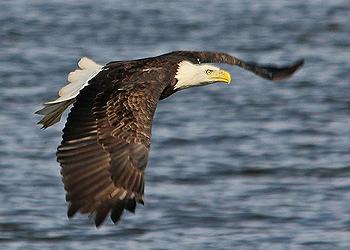
NEW YORK, New York, September 9, 2014 (ENS) – At the current pace of climate change, 314 species of North American birds could lose half or more of their livable ranges by the year 2080 if nothing is done to stop the release of greenhouse gases into the atmosphere, finds a scientific study issued Monday by the National Audubon Society.
The national symbol of the United States, the Bald Eagle, could see its current summer range decrease by nearly 75 percent in the next 65 years.

Audubon President and CEO David Yarnold says, “Many of those severely threatened are birds like the Rufous Hummingbird or the Baltimore Oriole that we see every day, or love and cherish.”
“Some, like the Trumpeter Swan, Brown-headed Nuthatch, and American Avocet, could lose more than 99 percent of their livable range, which puts them at extreme risk for extinction,” says Yarnold.
These are conservative estimates based on cutting-edge science and state-of-the-art climate models, Yarnold explained, warning, “The reality could, in fact, be worse.”
“It’s a punch in the gut. The greatest threat our birds face today is global warming. That’s our unequivocal conclusion after seven years of painstakingly careful and thorough research,” said Audubon Chief Scientist Gary Langham, who led the study, which was funded in part by the U.S. Fish and Wildlife Service.
“Global warming threatens the basic fabric of life on which birds, and the rest of us, depend, and we have to act quickly and decisively if we are going to avoid catastrophe for them and for us,” said Langham.
Langham and other Audubon ornithologists analyzed 30 years of North American climate data and tens of thousands of historical bird observations from the Audubon Christmas Bird Count and U.S. Geological Survey’s North American Breeding Bird Survey to understand the links between where birds live and the climatic conditions that support them.
Audubon is using the results of this study as an urgent call to action to protect “climate strongholds,” key places that will continue to support bird life in the coming decades.
Audubon Monday launched a climate initiative to give North American residents the information, the training, and the tools they need to create solutions – in backyards, communities, states and provinces.
The group encourages people to read the report at: climate.audubon.org and to share their own stories of climate change.
“Many bird species are already struggling,” said Yarnold, “victims of habitat loss, pollution, and man-made obstacles like skyscrapers and towers. Our urgent climate warning comes on top of an already crowded and urgent agenda for conserving birds and their habitats.”

“The prospect of such staggering loss is horrific, but we can build a bridge to the future for America’s birds,” said Yarnold. “This report is a roadmap, and it’s telling us two big things: We have to preserve and protect the places birds live, and we have to work together to reduce the severity of global warming.”
The Common Loon, icon of the north and state bird of Minnesota, may no longer be able to breed in the lower 48 states by 2080.
The Baltimore Oriole, state bird of Maryland and mascot for Baltimore’s baseball team, may no longer nest in the Mid-Atlantic, shifting north instead to follow the climatic conditions it requires.
Other state birds at risk include Brown Pelican (Louisiana), California Gull (Utah), Hermit Thrush (Vermont), Mountain Bluebird (Idaho and Nevada), Ruffed Grouse (Pennsylvania), Purple Finch (New Hampshire) and Wood Thrush (Washington, DC).
“We know that climate variables, including temperature and precipitation, determine where most birds live and where they don’t, because it is too hot, for example,” said Dr. Terry Root, a Nobel Prize-winning Stanford University professor who serves on Audubon’s board of directors but was not involved in the study.
“The Audubon study determined the climate variables that dictate where all North American birds live today and then brilliantly used climate forecasts to project where birds will most likely occur in the future. We all will see the effects of changing climate in our own backyards,” said Root. “We just cannot ignore such a sobering wake-up call.”
“This new North American study is consistent with results from Europe, Africa and Asia showing that climate change will have profound impacts on the world’s birds, with many more species projected to be in trouble than benefiting,” said Dr. Stuart Butchart, head of science with BirdLife International, the world’s largest bird conservation partnership with 120 BirdLife partners worldwide, one per country.
Butchart said the Audubon study also “points towards the actions that are needed to help wildlife adapt to a changing environment, including the urgent need to strengthen effective conservation of the world’s 12,000 Important Bird and Biodiversity Areas: the global network of sites that are critical for the conservation of birds and other wildlife.”
Copyright Environment News Service (ENS) 2014. All rights reserved.
© 2014, Environment News Service. All rights reserved. Content may be quoted only with proper attribution and a direct link to the original article. Full reproduction is prohibited.
